Museo di Capodimonte
Museo di Capodimonte is an art museum located in the Palace of Capodimonte, a grand Bourbon palazzo in Naples, Italy. The museum is the prime repository of Neapolitan painting and decorative art, with several important works from other Italian schools of painting, and some important ancient Roman sculptures. It is one of the largest museums in Italy.
Palace of Capodimonte | |

| |
| Established | 1757 |
|---|---|
| Location | Via Miano, 2 80131 Naples, Italy |
| Coordinates | 40.86700°N 14.250555°E |
| Type | Art museum, Historic site |
| Visitors | 193 055[1](2016) |
| Website | Official website Museo di Capodimonte |
History
The vast collection at the museum traces its origins back to 1738. During that year King Charles VII of Naples and Sicily (later Charles III, king of Spain) decided to build a hunting lodge on the Capodimonte hill, but then decided that he would instead build a grand palace, partly because his existing residence, the Palace of Portici, was too small to accommodate his court, and partly because he needed somewhere to house the fabulous Farnese art collection which he had inherited from his mother, Elisabetta Farnese, last descendant of the sovereign ducal family of Parma.
Over the years the palace was enlarged and filled with more art. In 1787, on the advice of Jacob Philipp Hackert, a laboratory for the restoration of paintings was created.
When the Parthenopaean Republic was declared in 1799, King Ferdinand IV fled to Palermo on board Nelson's Vanguard, taking the most valuable items from the museum with him. What remained was looted by the French troops of General Championnet who were billeted there during the short life of the Republic in 1799. Later on during the ten years of French reoccupation (1806 to 1815), the art collection was transferred to the Naples National Archaeological Museum. When King Ferdinand returned from Sicily in 1815, he employed many painters and sculptors to work on the redecoration of the palace . It was finally completed in 1840, and a gallery housing contemporary art was added.
After the palace passed in 1861 to the House of Savoy, further pieces were added to the art collections, appointing Domenico Morelli as consultant for new acquisitions. They also added an extensive collection of historic firearms and other weapons. In 1866, the boudoir of Maria Amalia of Saxony was transferred to Capodimonte from the Palace of Portici, and in 1877 a Roman era marble floor was brought in from a Roman villa on Capri.
After the end of the monarchy, the palace became purely a national museum in 1950, with many of the exhibits being returned from the National Museum.
Collection
The first and second floors house the Galleria Nazionale (National Gallery), with paintings from the 13th to the 18th centuries including major works by Simone Martini, Raphael, Titian, Caravaggio, Masaccio, Lorenzo Lotto, Giovanni Bellini, Giorgio Vasari, El Greco, Jacob Philipp Hackert and many others. The museum is by far the best place to see paintings of the Neapolitan School, often under-appreciated by the wider world, with large holdings of Jusepe de Ribera, Luca Giordano, the Neapolitan Caravaggisti and many others (see List of works in the Galleria Nazionale di Capodimonte). Much of the ground floor is taken up by part of the magnificent Farnese collection of classical, mostly Roman, monumental sculpture, which survives here and in the Naples National Archaeological Museum largely intact.
Elsewhere in the palace the royal apartments are furnished with antique 18th-century furniture and a collection of porcelain and majolica from the various royal residences
Collection Highlights
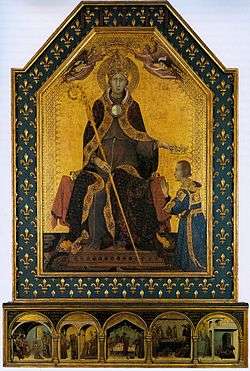 Toulouse Altarpiece by Simone Martini. c. 1317
Toulouse Altarpiece by Simone Martini. c. 1317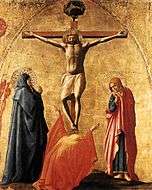 Crucifixion by Masaccio. c. 1426
Crucifixion by Masaccio. c. 1426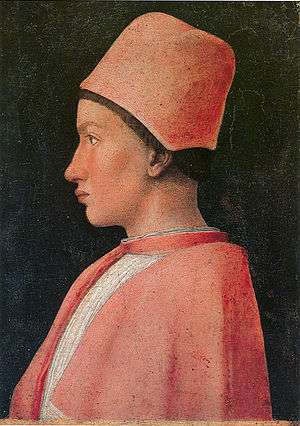 Portrait of Francesco Gonzaga by Andrea Mantegna. c. 1461
Portrait of Francesco Gonzaga by Andrea Mantegna. c. 1461.jpg) Madonna and Child and Two Angels by Botticelli. c. 1470
Madonna and Child and Two Angels by Botticelli. c. 1470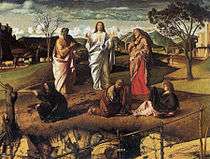 Transfiguration by Giovanni Bellini. c. 1480
Transfiguration by Giovanni Bellini. c. 1480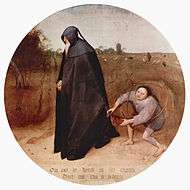 The Misanthrope by Pieter Bruegel the Elder. c. 1568
The Misanthrope by Pieter Bruegel the Elder. c. 1568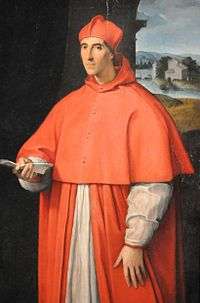 Portrait of Cardinal Alessandro Farnese by Raphael. c. 1509–1511
Portrait of Cardinal Alessandro Farnese by Raphael. c. 1509–1511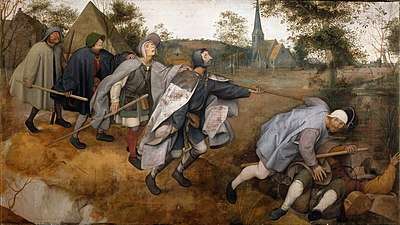
 Antea by Parmigianino. c. 1524–1527
Antea by Parmigianino. c. 1524–1527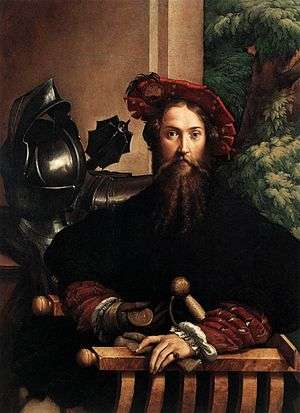 Portrait of Galeazzo Sanvitale by Parmigianino. c. 1524
Portrait of Galeazzo Sanvitale by Parmigianino. c. 1524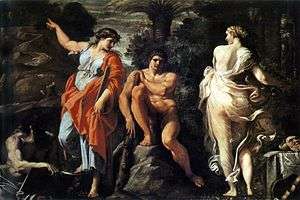 The Choice of Hercules by Annibale Carracci. c. 1596
The Choice of Hercules by Annibale Carracci. c. 1596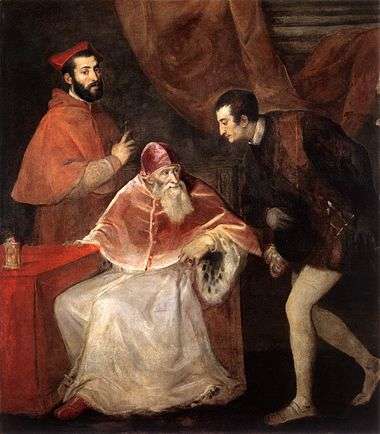 Pope Paul III and his Grandsons, Titian. c. 1546
Pope Paul III and his Grandsons, Titian. c. 1546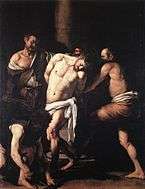 The Flagellation by Caravaggio. c. 1607–1608
The Flagellation by Caravaggio. c. 1607–1608 Madonna and Child with Saint Peter Martyr by Lorenzo Lotto. c. 1503
Madonna and Child with Saint Peter Martyr by Lorenzo Lotto. c. 1503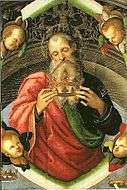 Baronci Altarpiece by Raphael. c. 1500–1501
Baronci Altarpiece by Raphael. c. 1500–1501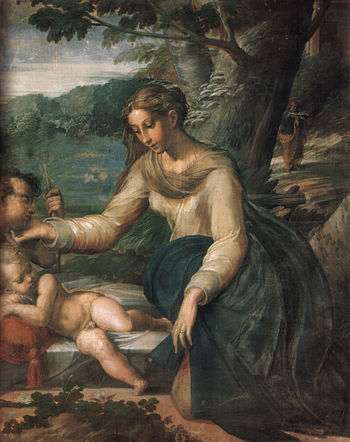 Holy Family with St. John by Parmigianino. c. 1528
Holy Family with St. John by Parmigianino. c. 1528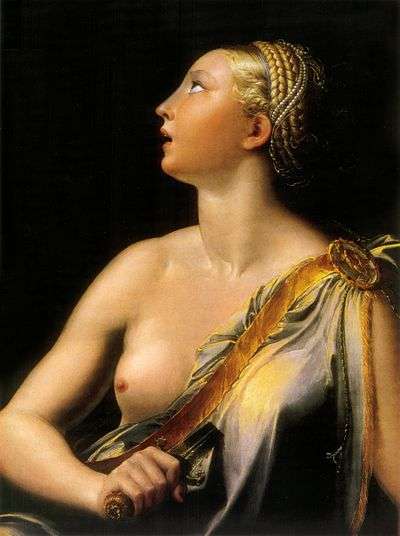 Lucretia by Parmigianino. c. 1540
Lucretia by Parmigianino. c. 1540_-_WGA10422.jpg) A Boy Blowing on an Ember to Light a Candle by El Greco. c. 1570–1572
A Boy Blowing on an Ember to Light a Candle by El Greco. c. 1570–1572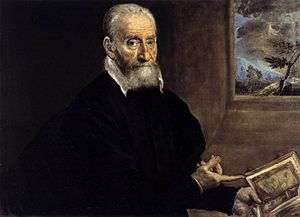 Portrait of Giulio Clovio by El Greco. c. 1571–1572
Portrait of Giulio Clovio by El Greco. c. 1571–1572 Mary Magdalena by Titian. c. 1550
Mary Magdalena by Titian. c. 1550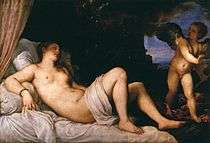 Danae by Titian. c. 1545
Danae by Titian. c. 1545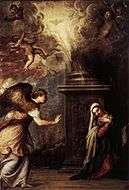 The Annunciation by Titian. c. 1557
The Annunciation by Titian. c. 1557 Portrait of Pope Paul III by Titian. c. 1543
Portrait of Pope Paul III by Titian. c. 1543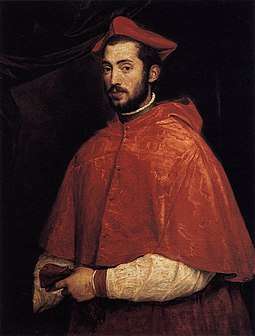 Portrait of Cardinal Alessandro Farnese by Titian. c. 1545–1546
Portrait of Cardinal Alessandro Farnese by Titian. c. 1545–1546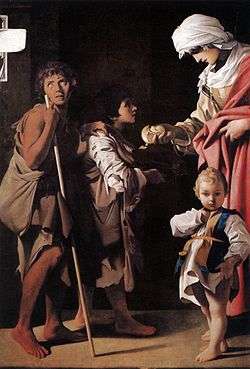 Charity by Bartolomeo Schedoni. c. 1611
Charity by Bartolomeo Schedoni. c. 1611.jpg) Ferdinando IV and His Family by Angelica Kauffman. c. 1783
Ferdinando IV and His Family by Angelica Kauffman. c. 1783 Mystical Marriage of St. Catherine by Correggio. c. 1520
Mystical Marriage of St. Catherine by Correggio. c. 1520
References
- "Dati visitatori" (PDF). beniculturali.it. Retrieved 25 January 2017.
Bibliography
- Nicola Spinosa (1999). Capodimonte (in Italian). Milan: Electa. ISBN 88-435-8613-0.
- Le Guide di Dove - Campania, Corriere della sera, 2007.
- Il Museo di Capodimonte, valori di Napoli, Pubblicomit, 2002.
External links
| Wikimedia Commons has media related to National Museum of Capodimonte (Naples). |
- Museo di Capodimonte official website (in Italian)